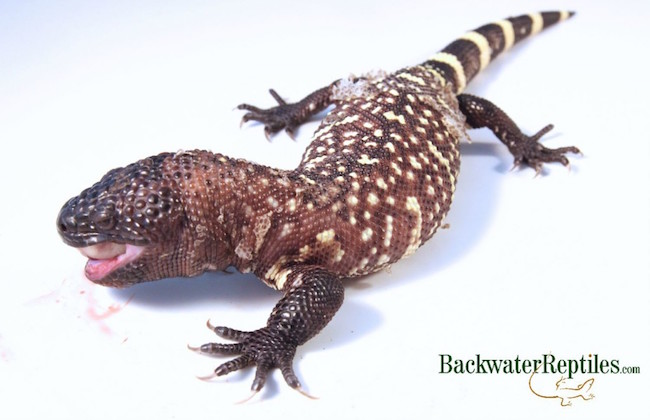Are you wondering which lizards are venomous? Everyone knows that there are many species of venomous snakes in the world – rattlers, black mambas, and cobras being probably the most well-known. But did you know that there are actually two species of venomous lizards too?
Venomous Lizard #1 – Gila Monster (Heloderma suspectum)
Gila monsters are native to the southwestern deserts of the U.S. and northwestern Mexico. They are the largest land-dwelling lizard in the U.S. and can reach lengths of up to two feet and weigh over five pounds. They are black with orange, red, or pinkish-colored patches.
Because they are considered a threatened species (not to mention are dangerous animals!) it’s not always legal to keep a gila monster as a pet. It varies depending on where you live.
The venom of a gila monster is a fairly mild neurotoxin. The lizard does not possess fangs but does have sharp, serrated teeth. This means that in order to inject its venom, the monster will bite, hang on, and chew to allow the wound to open up and the venom to flow into the bloodstream. In other words, their teeth do not “inject” venom. Ultimately, because it bites like a bulldog, the bite will be very painful and could cause temporary paralysis or difficulty breathing, but is generally not fatal if treated properly.
By nature, Gilas are burrowers and in captivity, they behave much the same as they would in the wild. They spend most of their lives under ground and will eat voraciously, so if you are keeping gila monsters, you should probably be an experienced herp hobbyist who knows the habits of these lizards.
Venomous Lizard #2 – Beaded Lizard (Heloderma horridum)
The Beaded Lizard is a close relative to the Gila Monster with similar body shape, venom delivery methods, and even skin texture. The Beaded Lizard gets larger than the Gila Monster though and can max out at three feet long and weigh as much as 45% more than its lizard cousin. Beaded lizards are also typically duller in color with browner bodies and white or yellowish splotches.

Because the Beaded Lizard and Gila Monster both primarily consume eggs, scientists are not 100% sure as to why these lizards are venomous. Interestingly enough though, the Beaded Lizard’s venom has been discovered to contain enzymes that are useful in the treatment of diabetes.
Fun fact: the Beaded lizard can consume around 30% of its body weight in one feeding! We feed ours thawed fuzzy mice, around six per feeding, and the lizard is barely a foot long.
Beaded lizards (and gila monsters) use their tongues much like snakes do to taste and smell the air. They possess Jacobson’s organs which filter the sensory data obtained by their tongues so that it can be transmitted to their brains for interpretation.
The venom of the Beaded Lizard causes respiratory paralysis and failure, but is rarely fatal to humans.
Honorable Mention #1 – The Komodo Dragon (Varanus komodoensis)
Komodos are extremely large lizards and therefore eat large prey animals such as deer, wild pigs, and even water buffalo. Sometimes the Komodo Dragon doesn’t manage to kill its prey in a single sitting, but the dragon is a patient lizard and will wait until it’s venom has worked its magic, which depending on the size of the animal, could take a day or two.
Venom researcher Bryan Fry discovered that the Komodo’s venom is delivered via chewing, much like the Beaded Lizard and Gila Monster’s venom. Once the venom has entered the blood stream, it can cause rapid decrease in blood pressure, expedite blood loss, and send a bitten animal into shock, making the prey animal too weak to escape or fight back.
Honorable Mention #2 – Monitor Lizard Family & Iguana Family
New scientific research suggests that monitor lizards and lizards in the iguana family also possess venom glands. Not to worry though – your pet iguana or pet Savannah monitor is not dangerous to you through its bite. The trace amounts of venom produced in these lizards is only strong enough to take down small prey items such as mice or birds. It is not harmful to people.
This is still a somewhat controversial topic of discussion and we’re awaiting further scientific data and studies until we officially proclaim monitors and iguanas venomous for the purposes of this blog.


